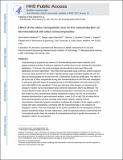| dc.contributor.author | Martín-Moldes, Zaira | |
| dc.contributor.author | López Barreiro, Diego | |
| dc.contributor.author | Buehler, Markus J | |
| dc.contributor.author | Kaplan, David L | |
| dc.date.accessioned | 2023-03-16T12:56:40Z | |
| dc.date.available | 2023-03-16T12:56:40Z | |
| dc.date.issued | 2021 | |
| dc.identifier.uri | https://hdl.handle.net/1721.1/148567 | |
| dc.description.abstract | © 2020 Understanding the properties and behavior of biomineralized protein-based materials at the organic-inorganic interface is critical to optimize the performance of such materials for biomedical applications. To that end, this work investigates biomineralized protein-based films with applications for bone regeneration. These films were generated using a chimeric protein fusing the consensus repeat derived from the spider Nephila clavipes major ampullate dragline silk with the silica-promoting peptide R5 derived from the Cylindrotheca fusiformis silaffin gene. The effect of pH on the size of silica nanoparticles during their biomineralization on silk films was investigated, as well as the potential impact of nanoparticle size on the differentiation of human mesenchymal stem cells (hMSCs) into osteoblasts. To that end, induction of the integrin αV subunit and the osteogenic markers Runx2 transcription factor and Bone Sialoprotein (BSP) was followed. The results indicated that pH values of 7-8 during biomineralization maximized the coverage of the film surface by silica nanoparticles yielding nanoparticles ranging 200-500 nm and showing enhanced osteoinduction in gene expression analysis. Lower (3-5) or high (10) pH values led to lower biomineralization and poor coverage of the protein surfaces, showing reduced osteoinduction. Molecular dynamics simulations confirmed the activation of the integrin αVβ3 in contact with silica nanoparticles, correlating with the experimental data on the induction of osteogenic markers. This work sheds light on the optimal conditions for the development of fit-for-purpose biomaterial designs for bone regeneration, while the agreement between experimental and computational results shows the potential of computational methods to predict the expression of osteogenic markers for biomaterials. Statement of Significance: The ability of biomineralized materials to induce hMSCs differentiation for bone tissue regeneration applications was analyzed. Biomaterials were created using a recombinant protein formed by the consensus repeat derived from the spider Nephila clavipes major ampullate dragline silk and the silica-promoting peptide R5 derived from the Cylindrotheca fusiformis silaffin gene. A combination of computational and experimental techniques revealed the optimal conditions for the synthesis of biomineralized silk-silica films with enhanced expression of markers related to bone regeneration. | en_US |
| dc.language.iso | en | |
| dc.publisher | Elsevier BV | en_US |
| dc.relation.isversionof | 10.1016/J.ACTBIO.2020.10.043 | en_US |
| dc.rights | Creative Commons Attribution-Noncommercial-Share Alike | en_US |
| dc.rights.uri | http://creativecommons.org/licenses/by-nc-sa/4.0/ | en_US |
| dc.source | PMC | en_US |
| dc.title | Effect of the silica nanoparticle size on the osteoinduction of biomineralized silk-silica nanocomposites | en_US |
| dc.type | Article | en_US |
| dc.identifier.citation | Martín-Moldes, Zaira, López Barreiro, Diego, Buehler, Markus J and Kaplan, David L. 2021. "Effect of the silica nanoparticle size on the osteoinduction of biomineralized silk-silica nanocomposites." Acta Biomaterialia, 120. | |
| dc.contributor.department | Massachusetts Institute of Technology. Department of Civil and Environmental Engineering | en_US |
| dc.relation.journal | Acta Biomaterialia | en_US |
| dc.eprint.version | Author's final manuscript | en_US |
| dc.type.uri | http://purl.org/eprint/type/JournalArticle | en_US |
| eprint.status | http://purl.org/eprint/status/PeerReviewed | en_US |
| dc.date.updated | 2023-03-16T12:34:31Z | |
| dspace.orderedauthors | Martín-Moldes, Z; López Barreiro, D; Buehler, MJ; Kaplan, DL | en_US |
| dspace.date.submission | 2023-03-16T12:34:33Z | |
| mit.journal.volume | 120 | en_US |
| mit.license | PUBLISHER_CC | |
| mit.metadata.status | Authority Work and Publication Information Needed | en_US |
